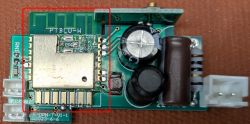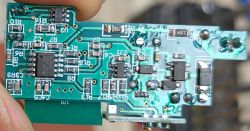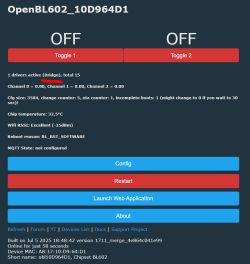I'm looking for help to identify the module and thus the pinout (for flashing) for the wifi module in a EARU EAKCB-EWE-M "circuit breaker" that I just bought off AliExpress
https://www.aliexpress.com/item/1005006189189642.html
** Update: with wonderful help from forum members, the EAKCB-EWE-M circuit breaker and associated PTBLU-W wifi module are fairly well documented. Follow this link to get teardown info and pictures, pin out, and other details: https://www.elektroda.com/rtvforum/topic4129041.html#21598413 **
I've verified that it works with ewelink so I'm hoping I can flash it with new firmware (e.g. OpenBK or Tasmota). I'm attaching pictures of the front and back of the circuit board containing the wifi module.
FRONT of circuit board (Wifi module circled in red)

BACK of circuit board

The only marking I see is "PTBLU-W" in the silkscreen and searching the web comes up empty. There are no markings on the RF shield no matter which angle I look at it. Based on a post I found, I was hoping it would be the PSF-B module mentioned in: https://www.elektroda.com/rtvforum/topic4068651.html but no such luck.
I'd use a sonoff device, but they generally have a current limit around 20A or less (for a single channel); I need to monitor and control a higher current (30-35A for my EV) and this has a relay rated for 60A.
Thanks in advance for any help you can offer.
https://www.aliexpress.com/item/1005006189189642.html
** Update: with wonderful help from forum members, the EAKCB-EWE-M circuit breaker and associated PTBLU-W wifi module are fairly well documented. Follow this link to get teardown info and pictures, pin out, and other details: https://www.elektroda.com/rtvforum/topic4129041.html#21598413 **
I've verified that it works with ewelink so I'm hoping I can flash it with new firmware (e.g. OpenBK or Tasmota). I'm attaching pictures of the front and back of the circuit board containing the wifi module.
FRONT of circuit board (Wifi module circled in red)

BACK of circuit board

The only marking I see is "PTBLU-W" in the silkscreen and searching the web comes up empty. There are no markings on the RF shield no matter which angle I look at it. Based on a post I found, I was hoping it would be the PSF-B module mentioned in: https://www.elektroda.com/rtvforum/topic4068651.html but no such luck.
I'd use a sonoff device, but they generally have a current limit around 20A or less (for a single channel); I need to monitor and control a higher current (30-35A for my EV) and this has a relay rated for 60A.
Thanks in advance for any help you can offer.








